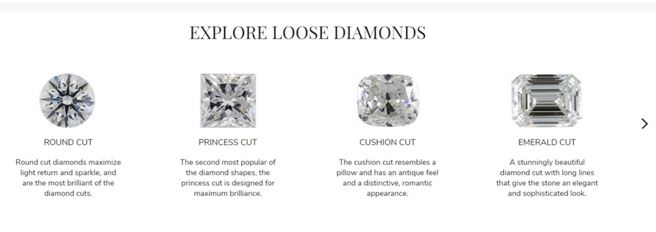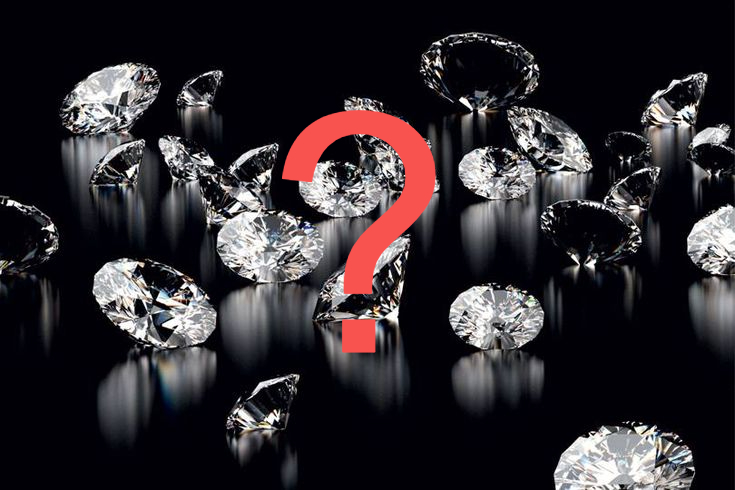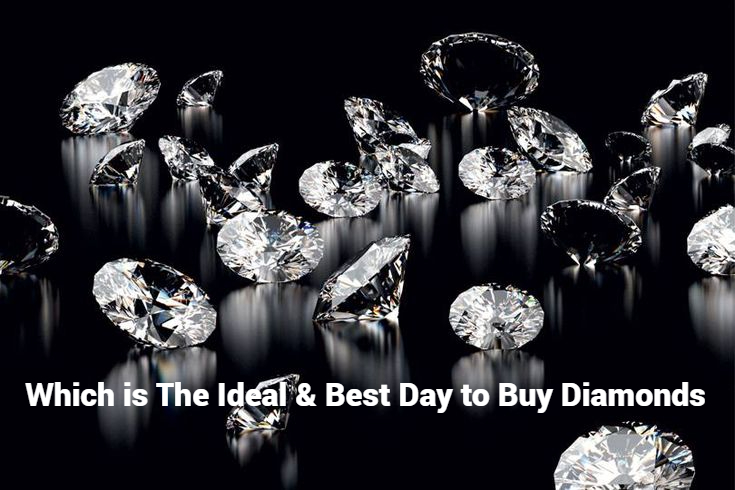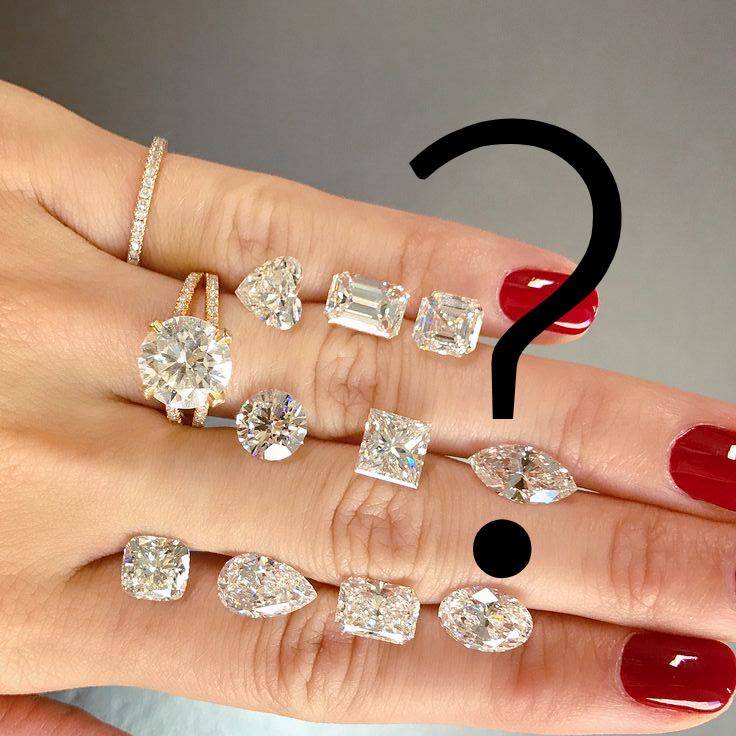- Introduction
-
- Clarity refers to how flawless or inclusion-free a diamond is. It is graded by the GIA into:
- Flawless (FL)
- Internally flawless (IF)
- Very Very Slightly Included (VVS1 and VVS2)
- Very Slightly Included (VS1 and VS2)
- Slightly Included (SI and S2)
- Included (I1, I2, and I3)
- The VVS diamond
- Diamonds in this clarity grade have inclusions which cannot be seen with the naked eye
- The VVS1 diamonds have inclusions which are extremely very difficult to see at 10xmagnification.
- The reason for this is that the inclusions are located at the pavilion, below the girdle which hides them
- The VVS2 diamonds have inclusions that are very difficult to see located at the crown of the diamond.
- Factors that GIA considers when in grading diamonds include:
- Size: The larger the inclusion relative to the diamond, the lower the grade and vice versa
- Number: Higher numbers of inclusions have a higher chance of being visible
- Relief: refers to how contrasting the inclusion is.
- A well-blended inclusion would be less obvious and one with more contrast with the rest of the diamond would be more obvious.
- Nature: Some inclusions, like large feathers and cracks, are more obvious. Needles, pinpoint, cloud are less obvious and so the containing diamond would rank higher.
- The price range of the VVS diamonds
- Ideally, the higher clarity diamond should have a higher price, but this is not the case.
- The price is determined by an interplay of the clarity with other factors like :
- Cut
- Color
- Carat
- The clarity alone cannot determine the price of a diamond.
- Where to get a VVS diamond
- Online stores, although you must always insist on seeing the GIA report so you do not have a false grading
- Offline stores do not routinely stock VVS grade diamonds. You would most likely have more limited options
- Advantages of Picking a VVS diamond
- It is close to perfection. It is just the next grade after the Flawless and Internally Flawless
- It helps you save some more since the inclusions are invisible to the naked eye. You can buy it instead of the flawless grade
- The VVS grade is not as common as other lower grades
- Disadvantages of picking a VVS Diamond
- Buying a VVS diamond does not guarantee a quality diamond since other factors like cut, color, and carat are involved
- Since it is not routinely stocked, the VVS diamond can be difficult to find, especially offline. It can lead to limited options
- It is expensive, compared to a VS diamond, which also has inclusions that are not visible to the naked eye
- The clarity grading might be incorrect
- The factor that determines what you pick
- Preference: Pick a diamond that suits your taste
- Budget: Select a diamond that matches your budget
- Pick a diamond that would fit the use for which it was intended, considering the setting
- Clarity refers to how flawless or inclusion-free a diamond is. It is graded by the GIA into:
INTRODUCTION
You might have heard of different people talk about the 4Cs of a diamond. Extensive discussions about them are always ongoing in the diamond world. The 4Cs are Cut, Clarity, Color and Carat.
It is widely agreed that the most important characteristic of the diamond is the Cut. Most people would prefer to use the cut as a judge when they want to select a diamond to buy. It is expected, as the cut determines any features like the scintillation, brightness, fire, and sparkle.
However, we would examine an aspect of clarity grading in this article.
Clarity refers to how inclusion-free or flawless a diamond is. In simple terms, clarity affects how the diamond is perceived. If the diamond has very obvious flaws, then these flaws could affect the beauty and brightness of the diamond. It is on this basis that the GIA has drafted a clarity grading system. Diamonds that have very minimal inclusions are graded highly, while those with obvious and structure-threatening inclusions are graded very low on the scale.
Briefly let us examine different grades of clarity according to GIA:
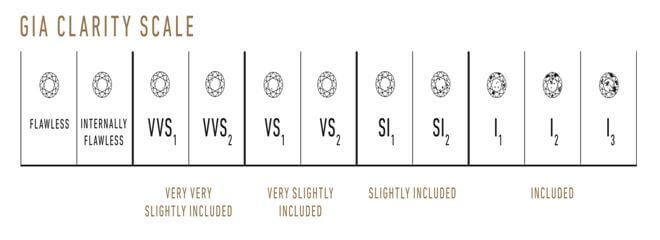
- Flawless: Diamonds in this category are known to have no flaws or inclusions whatsoever. They constitute only about 0.1% of all diamonds and you would agree that they are extremely rare. This makes them more unique and as expected, much more expensive than other diamonds. If diamonds in this category are viewed at 10x magnification, there would still be no visible flaws, hence the name ‘flawless.’
- Internally Flawless: Internally flawless diamonds are diamonds that have blemishes (flaws that affect the external surface of the diamond and can only be seen on 10x magnification. The interior of the diamond is flawless and this is the reason for the name ‘internally flawless.’
- Very Very slightly Included (VVS1): This is the focus of this article and would be examined critically in the next section. This grade has very minute inclusions which are extremely difficult to visualize even at 10x magnification. It is subdivided into the VVS1 and VVS2. We would examine them in detail later.
- Very Slightly Included (VS): This grade has inclusions that are invisible to the unaided eye but can be picked up at 10x magnification. They are the most popular clarity grade among most diamonds. This grade is also divided into VS1 and VS2
- Slightly Included: This group of diamonds has inclusions that are detected on 10x magnification but might also be visible to the naked eye. It is also divided into the SI1 and SI2 grades.
- Included: Has inclusions that can be seen with the naked eye. It is divided into I1, I2, and I3. Inclusions present here can affect the structural integrity of the diamond.
Now that we have a basic understanding of how the GIA grading system for clarity works, we can go ahead to discuss the Very Very Slightly Included diamonds (VVS diamonds).
THE VVS DIAMOND
The Very Very slightly included grade of diamond clarity is the grade that has inclusions which are not obvious to the naked eye and are extremely difficult (for the VVS1) and very difficult (VVS2) to pick on 10x magnification. There are two subgrades in the VVS grade: VVS1 and VVS2.
The VVS diamond is the one between the Flawless and the Very Slightly included. It is the point where the inclusions become visible on 10x magnification. As such, it is a type of transition between perfection and almost perfect. As we know, flawless diamonds are rare; therefore, the VVS is more common than they are.
HOW DOES THE GIA PLACE DIAMONDS INTO THE VVS GRADE?
To answer this question, we first have to understand how GIA grades diamonds generally, concerning clarity.
It should be noted that clarity has to do with how visible a blemish or inclusion is. The extent to which these factors are considered is the extent to which they affect the visibility of the inclusion or blemish.
To grade diamonds in terms of clarity, the GIA considers the following factors:
- Size: The size of the inclusion relative to the size of the diamond plays an important role, with all other factors constant. This means that a larger diamond with a large inclusion might have a higher clarity grade thana smaller diamond with the same-sized inclusion. This is because the inclusion would be more visible in the smaller diamond.
- Number: With all other factors like cut, color, and carat constant, a higher number of inclusions increase the chances that the inclusion would be seen at 10x magnification or even with the naked eye. Therefore, a diamond with a higher number of inclusions would most likely rank lower.
- Relief refers to the contrast that the blemish or inclusion makes with the rest of the diamond. So, if an inclusion has a very light or dark shade which is very easily visible, it would definitely rank lower in the clarity grading scale.
- Nature: the nature of the inclusion would also influence the grade. Some blemishes or inclusions are more obvious than others and would lower the clarity grade of the diamond.
Now that we know how GIA does it for every grade, we can now understand how GIA places a diamond in the VVS grade.
The VVS grade has some inclusions that are common to it. You can expect to find needles, pinpoints, internal graining, and clouds. All these types of inclusions would not affect the outward appearance of the diamond.
The location of the inclusion would now determine if it is VVS1 or VVS2.
For the VVS1, the inclusions are usually positioned at the pavilion of the diamond. At this position, the inclusion is well hidden by the girdle, so at 10x magnification, this inclusion would be extremely difficult to see.
For the VVS, the inclusion, whether needle, pinpoint, clouds would be located on the crown, which might not be visible to the eye, but can be seen on 10x magnification, even though it would be very difficult to visualize it.
Note that for both grades, the inclusions are invisible to the naked eye and do not affect the external appearance of the stone in any way.
PRICE RANGE OF THE VVS
The Very Very Slightly Included diamonds have different price ranges. The reason for this is that it is not only the clarity grade that determines the price of the diamond. There is also the cut, which is a major factor, the color, and the Carat. It is the interplay of all these characteristics that would determine how expensive or cheap a diamond would be.
However, if all factors are constant, the VVS diamonds would always cost more than the VS diamonds and lesser than the Flawless grades.
But, since we do not live in a perfect world and when going to buy diamonds, not every factor would be ‘constant,’ it is important to understand what to look out for when buying VVS diamonds so that you get better value for your money.
As you must have noticed from these pictures of some diamonds available on James Allen, all the diamonds present here is VVS. But look at the price difference – for some as much as $3000!
Therefore, the price of the diamond is based on the combination of all the factors, not just the clarity grade alone.
The point here is that when you are going to buy your diamonds, make sure you understand that one characteristic is not enough to determine the rice. Try to combine, to get the best.
The VVS diamond gives you a cheaper to an alternative to a Flawless diamond.
Yes. For both grades, the flaws are invisible to the eyes and I do not know how many people go about carrying a 10x magnifying glass to check for inclusions!
Do you?
So, you do not really need a flawless diamond except for some specific purposes. You can save more from that and then get a higher cut grade.
If you are also working with a limited budget, you can go for a VVS2 grade, instead of a VVS1, then increase the cut or reduce the color.
This is the best way to get the most cost-effective deal. It does not make much sense to insist on a VVS1 and VVS2 and then get a poor diamond or maybe a good or fair cut grade. It defeats the purpose. Therefore, insist on getting a GIA grade report for the diamond you are about to buy, clearly showing the cut, clarity, carat and color grades.
A diamond of Very Good to Excellent cut grade and D –F color range would be perfect with a VVS1 or VVS2.
WHERE TO GET A VVS DIAMOND
You can get VVS diamonds at retail stores online or offline. However, we always recommend online stores, because they provide more information about the diamonds that they sell. Online stores James Allen, Brian Gavin and Whiteflash are known to sell quality VVS diamonds.
If you want to go for commercial retail stores offline, then you should know that most stores would not routinely stock VVS diamonds. VS diamonds are more commonly stocked. Therefore, VVS would most likely be obtained as they are needed.
The danger of buying online is that some of these retailers might have had no prior contact with the diamond. All the information displayed to you might be just what the manufacturer has said and might be unverified.
To combat this, insist on a GIA report for any diamond that you want to buy. This way, you are sure it is not just a self-acclaimed ‘excellent;’ or ‘VVS’ grade diamond.
ADVANTAGES OF PICKING A VVS DIAMOND
Having examined the VVS diamond in detail, why should you pick it?
- It is close to perfection: After the Flawless and Internally Flawless grade, the next in line is the Very Very slight included grade. The VVs grade represents the closest of other grades to perfection. Since the inclusions present are in minimal amounts, you can get a diamond that is almost perfect.
- It helps you save some more: A diamond that is of the VVS grade would not display any flaws or inclusions on physical examination. The Flawless or Internally flawless grade would also not display any flaws. Well, except people you move with go about with a 10x magnifying glass to show inclusions in other people’s diamonds, (which would be very awkward by the way), there is no reason why you should not go for a VVS grade and save more money that would have been wasted in getting a flawless grade of clarity.
- The VVS grade is not as common as other lower grades and this means that your diamond is quite unique. Infact, most retail stores do not routinely stock VVS diamonds. They usually have to order as demanded. You can have bragging rights among your friends that you are wearing an exclusive diamond.
Ok, are there disadvantages?
DISADVANTAGES OF BUYING A VVS DIAMOND
- Buying a VVS diamond does not guarantee a great looking diamond: This is sadly true. The reason for this, as you must have guessed is that clarity alone does not determine the appearance of a diamond. A diamond can be VVS grade but still have a very poor cut and this would definitely reduce significantly the brightness of the diamond. Clarity is much more appreciated when a diamond has other factors like cut and color well placed.
- It is not very easy to find: VVS diamonds might be very difficult to get offline. It is not routinely stocked, unlike the VS diamond, which is almost always available. Since the VVS diamonds are not very popular, it might mean that you are also getting a limited range of options and so you might not get the best diamond you were hoping to get. Even if you go online, there are still associated problems that have already been discussed.
- It can be expensive: Really, what is the difference between the VVS and VS to the layman on the street? VS diamonds also have inclusions that are invisible to the naked eye, so, why go for a VVS grade diamond? Why not reduce the clarity grade and increase the cut or color grade of the diamond? You can save more by going for a lower clarity grade and then increase other characteristics. Worse still, someone who gets a VS1 grade diamond with a better cut and color grade might even have a diamond with better sparkle and scintillation than you who bought a VVS diamond!
That might hurt…. You know
A difference of $2000 is no joke, especially when you do not get value for your money.
- The clarity grading might be incorrect: This is not a problem limited to the VVS grade alone. The diamond sellers might just give a grade that they deem fit and without verified reports from reputable labs like GIA, you might as well be getting a diamond of a lower clarity grade than expected.
WHICH SHOULD YOU PICK?
Now that you have read through, some people might be confused about which to go for. Should you go for the VVS diamond?
Well, I cannot make that decision for you. I can only guide you to ensure you pick the best that suits you. Your choice should depend on the following factors:
- Preference: Are you someone that likes wearing the best thing in the room? Do you take pride in being able to wear what no one else is wearing? Well, if that is you, then the VVS diamond might be just right for you. You get the bragging rights! Just ensure that other diamond characteristics are top-notch so you can get that ‘all-round diamond’ feeling. However, if you do not mind lowering the clarity grade on a paper, to get other characteristics, well, this might not be the best diamond for you. But the most important thing is to buy what you are happy to wear anytime and a day!
- Budget: This is a very important factor and to some people, the most important factor. You might want to save some more and if you look at other characteristics and it is just not adding up, you might want to go for a lesser clarity grade. However, if your budget allows you to go for a higher clarity grade, why not?
- The use for which the diamond would be put should also determine if you would need a very high clarity grade like the VVS diamond or not. Some settings can obscure inclusions, even when they are obvious. This type of setting would do well with a lower clarity grade. Other settings would make flaws more obvious and so of necessity would require a higher clarity grade.
Consumer satisfaction is the most important thing in buying and selling. Therefore, make sure that you get what you want and would be satisfied with it.
Finally, if you get confused at any point, do not hesitate to consult your gemologist.
Now, go get your diamond!
